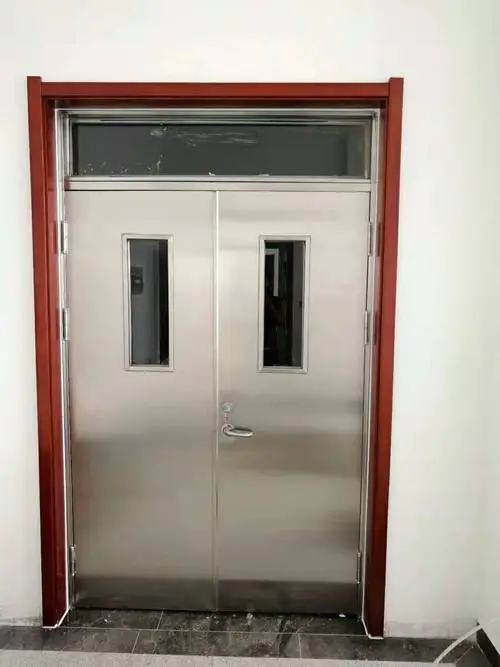Five Things You Need to Know About Fire Exit Doors
- 1. Fire Exit Doors Must Remain Unlocked for Emergency Evacuations
- 2. Proper Management of Fire Exit Doors in Residential and Commercial Buildings
- 3. Fire Exit Door Locks Are Designed for Emergencies
- 4. Fire Exit Door Accessibility and Compliance with Fire Safety Laws
- 5. Fire Exit Doors Are Vital for Both Evacuation and Firefighter Access
- Fire Exit Door Control Measures

1. Fire Exit Doors Must Remain Unlocked for Emergency Evacuations
One of the most important things to understand about fire exit doors is that they should never be locked. According to Article 28 of the Fire Protection Law, no entity or individual is allowed to block, lock, or obstruct evacuation passages, safety exits, or fire truck access routes. This ensures that during emergencies, people can quickly evacuate through designated fire exit doors without hindrance, and emergency responders can access the building efficiently.
2. Proper Management of Fire Exit Doors in Residential and Commercial Buildings
In practical applications, some residential complexes or commercial units may need to manage their fire exit doors to prevent unauthorized access while still maintaining fire safety compliance. This is often done by installing quick-release locking mechanisms. These locks prevent unauthorized entry under normal circumstances but can be quickly disengaged in the event of a fire or emergency.
3. Fire Exit Door Locks Are Designed for Emergencies
It’s crucial to use locks that meet safety standards. Specialized fire exit door locks are designed to alert when unauthorized attempts are made to open them, but in emergencies, they can be easily released to ensure safe evacuations. These locks comply with fire safety regulations and provide additional security in non-emergency situations while ensuring quick access during fire evacuations.
4. Fire Exit Door Accessibility and Compliance with Fire Safety Laws
For any firedoor management strategy, it’s essential to comply with local fire safety laws and regulations. Whether it’s in commercial buildings, schools, or residential properties, fire exit doors should always allow for fast, unobstructed evacuation. Any locking mechanism used must align with safety standards, ensuring that the doors remain accessible during emergencies.
5. Fire Exit Doors Are Vital for Both Evacuation and Firefighter Access
The main purpose of fire doors is not just to provide an escape route for building occupants but also to allow firefighters easy access to the building. In the event of a fire, unlocked and functional firedoors make it easier for fire crews to enter and exit quickly, minimizing response times and improving overall safety during emergencies.
Fire Exit Door Control Measures
- Fire Detection System
A fire detection system should be installed to ensure that fire doors automatically respond by closing when a fire occurs. These systems detect fires early, sending signals to trigger the closure of fire doors and prevent the spread of flames through corridors. - Automatic Closing Device
Fire doors should be equipped with automatic closing devices. Once a fire signal is detected, the doors close quickly to isolate the fire source and secure the evacuation route, protecting the safety of occupants. - Evacuation Time for Rescue Personnel
Fire doors should be designed to delay closing during a fire, allowing sufficient time for people to evacuate. The delay time can be adjusted depending on the building’s size and occupancy level to ensure that evacuation is efficient and safe. - Manual Control Device
In addition to automatic closing mechanisms, fire doors should also include manual controls, allowing occupants to operate the doors in case of emergencies. These manual controls ensure flexibility in managing the fire doors during evacuations. - Remote Monitoring System
Utilizing modern network technology, a remote monitoring system should be established to keep track of the status of the fire doors in real time. This system helps manage door performance, provides historical records, and ensures that necessary maintenance is carried out to keep the fire doors in optimal condition. - Maintenance Plan
Regular inspection and maintenance of the fire doors are vital to ensuring they function properly. The maintenance plan should include scheduled checks, repairs, and periodic fire drills to test the reliability of the doors and ensure safe evacuation in case of an emergency. - Alarm Response Measures
In the event of a malfunction, the fire doors should immediately trigger an alarm. Prompt repairs should be arranged, and a backup system should be in place to handle emergencies without delay.
In conclusion, fire exit doors should never be locked or obstructed in a way that prevents emergency evacuation. Proper fire exit door management ensures compliance with fire safety laws while maintaining security and accessibility in emergencies. For businesses and property managers, ensuring that fire exit doors are regularly inspected and maintained is a critical step in protecting lives and property.
